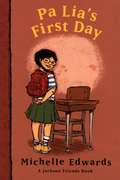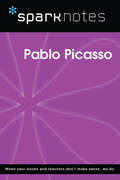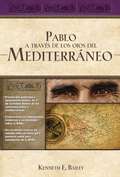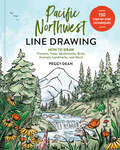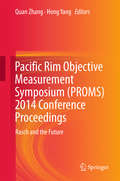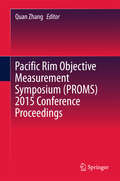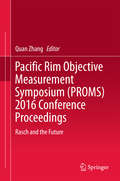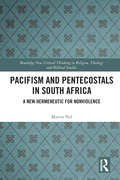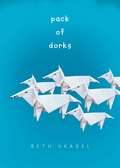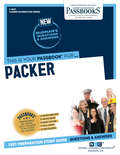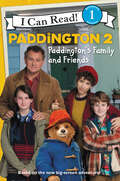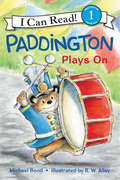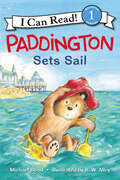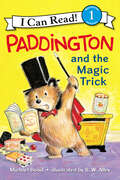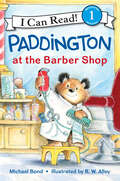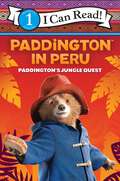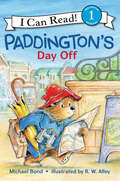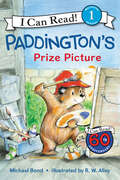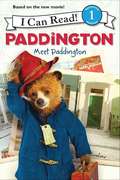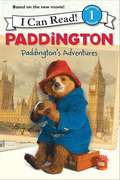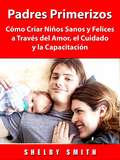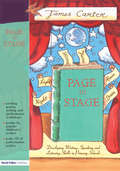- Table View
- List View
PYP Friends: The sleepover
by Dr Kimberley O'BrienA story about being pushed out of your comfort zones. And learning about team dynamics and how to work together. Meet the four friends who live on Quirky Lane and follow the stories of how they resolve conflict and strengthen their friendships. Child psychologist, Dr Kimberley O'Brien teams up with children's author Barbara Gonzales and talented illustrator Connah Brecon to create these inspiring childhood adventures and social skills stories.
PYP Friends: Ups and downs
by Dr Kimberley O'BrienWhat makes a good friend? Learn about different characteristics and how to repair a broken friendship. Meet the four friends who live on Quirky Lane and follow the stories of how they resolve conflict and strengthen their friendships. Child psychologist, Dr Kimberley O'Brien teams up with children's author Barbara Gonzales and talented illustrator Connah Brecon to create these inspiring childhood adventures and social skills stories.
Pa Lia's First Day
by Michelle EdwardsPa Lia Vang's first day at Jackson Magnet, her new school, isn't going so well. She doesn't know anyone. She can't find her second-grade classroom. And then she gets the only person who's been nice to her into trouble. Will Pa Lia ever fit in? In this first chapter book of the Jackson Friends series, Michelle Edwards explores with humor and sensitivity the anxieties children often face in a new situation.
Pablo Picasso (SparkNotes Biography Guide)
by SparkNotesPablo Picasso (SparkNotes Biography Guide) Making the reading experience fun! SparkNotes Biography Guides examine the lives of historical luminaries, from Alexander the Great to Virginia Woolf. Each biography guide includes:An examination of the historical context in which the person lived A summary of the person&’s life and achievements A glossary of important terms, people, and events An in-depth look at the key epochs in the person&’s career Study questions and essay topics A review test Suggestions for further reading Whether you&’re a student of history or just a student cramming for a history exam, SparkNotes Biography guides are a reliable, thorough, and readable resource.
Pablo a través de los ojos mediterráneos: Estudios culturales de Primera de Corintios
by Kenneth E. BaileyEn este innovador estudio de la Primera carta a los Corintios, Kenneth Bailey examina esta carta canónica a través de la formación judía socio-cultural y retórica de Pablo y a través del contexto mediterráneo de los corintios. Revelando las raíces de la carta en el hebreo tradicional profético, su organización intencional teológica y su referencia retórica a las prácticas culturales del Cercano Oriente, Bailey nos permite ver la perspectiva completa de la respuesta de Pablo a una comunidad en crisis.
Pacific Northwest Line Drawing: How to Draw Flowers, Trees, Mushrooms, Birds, Animals, Landmarks, and More
by Peggy DeanThis book of simple step-by-step line drawings from beloved art teacher Peggy Dean of The Pigeon Letters will deepen your appreciation for the wonders of the Pacific Northwest.Learn to draw 150 Pacific Northwest natural wonders (plus iconic landmarks) in just a few simple steps each! Rooted in love for the PNW, this no-skills-necessary how-to-draw book will encourage users to stop and notice the beauty that surrounds them. Here you&’ll learn the basics of line drawing as well as facts about the ecology, plants, wildlife, and landmarks of this amazing region. Inside you'll find:Native plants like salmonberries, sword ferns, and Pacific rhododendronMajestic trees like the Western red cedar and Douglas firMysterious mushrooms like the chanterelle and morelIconic animals like otters and orcasBucket-list birds like the Northern spotted owl and tufted puffinPopular landmarks like the Space Needle, Mount Rainier, and Crater LakeLine drawing is a meditative, easy-to-master art form featuring illustrative, doodle-like designs. Peggy, who has deep roots in the Pacific Northwest, teaches you how to start with the simplest doodles, building into more elaborate, delicate illustrations. These simple line drawings will allow you to branch out and have fun with your own personal style, as well as inspire you to add flourishes to other projects. Drawings are ordered from simple to advanced, and by category (flora, fauna, landmarks).If you enjoyed Ed Emberley as a child, you&’ll love this book of simple step-by-step line drawings with space to practice!
Pacific Rim Objective Measurement Symposium (PROMS) 2012 Conference Proceeding
by Hong Yang Quan ZhangEntrusted by the Board of Management of the Pacific Rim Objective Measurement Symposium (PROMS), PROMS2012 is held in Jiaxing, China from August 6-9, 2012. Over the past years, PROMS has been hosted in many parts of the Pacific Rim, in Singapore, Malaysia, Hong Kong, Taiwan and Tokyo, which has greatly promoted the research of and contributed to the development of Rasch Model in one way or another. As early as in 1980s, the ideas and concepts regarding IRT was first introduced into China by Prof. Gui Shichun, my Ph.D supervisor, and it is Prof. Gui who first conducted with great success the ten-year long (1990-1999) Equating Project for Matriculation English Test (MET) in China. MET is the most influential entrance examination for higher education administered annually to over 3.3 million candidates then. The Equating Project won recognition by Charles Alderson and other foreign counterparts during 1990s. Academically, those were Good Old Days for Chinese testing experts and psychometricians. Then for certain reasons, the equating practice abruptly discontinued. Therefore, in China nowadays, the application of IRT-based software like BILOG, Parscale, Iteman 4 and others to real testing problem solving is confined to an extremely small 'band' of people. In this sense, PROMS2012 meets an important need in that it provides an excellent introduction of IRT and its application. And anyone who is seriously interested in research and development in the field of psychometrics or language testing will find such a symposium and related workshops to be an excellent source of information about the application of Rasch Model. PROMS2012 focuses on recent advances in objective measurement and provides an international forum on both the latest research in using Rasch measurement and non-Rasch practice.
Pacific Rim Objective Measurement Symposium (PROMS) 2015 Conference Proceedings
by Quan ZhangThis book collects and organizes the original studies presented at PROMS 2015 conference on theories and applications of Rasch model. It provides useful examples of the Rasch model used to address practical measurement problems across a range of different disciplines including Item Response Theory (IRT), philosophy of measurement, dimensionality, the role of fit statistics and residuals, application, educational application, language testing, health-related research, business and industrial application and Rasch-based computer software. PROMS 2015 (Pacific Rim Objective Measurement Symposium) was held from August 20-24th 2015, in Fukuoka, Japan. The goal of this conference is to bring together the researchers from academia, universities, hospitals, industry, management sector as well as practitioners to share ideas, problems and solutions relating to the multifaceted aspects of Rasch Model.
Pacific Rim Objective Measurement Symposium (PROMS) 2016 Conference Proceedings: Rasch And The Future
by Quan ZhangThis book gathers original studies presented at the PROMS 2016 conference on Rasch theories and Rasch-based applications. It provides significant examples used to address practical measurement problems across a range of disciplines, including: Classic Testing Theory (CTT), Item Response Theory (IRT), philosophy of measurement, dimensionality, the role of fit statistics and research, business and industrial applications, health-related research and the latest Rasch-based computer software. PROMS welcomes empirical and theoretical studies and workshops, preferably with an emphasis on the Rasch model. Special attention is paid to manuscripts submitted by non-native English-speaking authors from Pacific Rim countries, regions and beyond. PROMS 2016 (Pacific Rim Objective Measurement Symposium) was held July 30-August 3, 2016 in Xi’an, China. The goal of the conference was to bring together researchers, scholars and professors from research institutes, universities, hospitals, business and management sectors, as well as professional practitioners, to exchange and share ideas, problems and solutions regarding the multifaceted aspects of the Rasch model and on the much debated yet highly topical issues of objective assessment.
Pacifism and Pentecostals in South Africa: A new hermeneutic for nonviolence (Routledge New Critical Thinking in Religion, Theology and Biblical Studies)
by Marius NelMost of the early twentieth-century Pentecostal denominations were peace churches that encouraged a stance of conscientious objection. However, since the Second World War Pentecostals have largely abandoned their pacifist viewpoint as they have taken on a more literal Biblical hermeneutic from their interaction with Evangelical denominations. This book traces the history of nonviolence in Pentecostalism and suggests that a new hermeneutic of the Bible is needed by today’s Pentecostals in order for them to rediscover their pacifist roots and effect positive social change. The book focuses on how Pentecostalism has manifested in South Africa during the twentieth century. Much of the available academic literature on hermeneutics and exegesis in the field of Pentecostal Studies is of an American or British-European origin. This book redresses this imbalance by exploring how the Bible has been used amongst African Pentecostals to teach on the apparent paradox of a simultaneously wrathful and loving God. It then goes onto suggest that how the Bible is read directly affects how Pentecostals view their role as potential reformers of society. So, it must be engaged seriously and thoughtfully. By bringing Pentecostalism’s function in South African society to the fore, this book adds a fresh perspective on the issue of pacifism in world Christianity. As such it will be of great use to scholars of Pentecostal Studies, Theology, and Religion and Violence as well as those working in African Studies.
Pack of Dorks (Pack of Dorks #1)
by Beth VrabelLucy knows that kissing Tom Lemmings behind the ball shed will make her a legend. But she doesn't count on that quick clap of lips propelling her from coolest to lamest fourth grader overnight. Suddenly Lucy finds herself trapped in Dorkdom, where a diamond ring turns your finger green, where the boy you kiss hates you three days later, where your best friend laughs as you cry, where parents seem to stop liking you, and where baby sisters are born different.Now Lucy has a choice: she can be like her former best friend Becky, who would do anything to claim her seat at the cool table in the cafeteria, or Lucy can pull up a chair among the solo eaters-also known as the dorks. Still unsure, Lucy partners with super quiet Sam Righter on a research project about wolves. Lucy connects her own school hierarchy with what she learns about animal pack life-where some wolves pin down weaker ones just because they can, and others risk everything to fight their given place in the pack. Soon Lucy finds her third option: creating a pack of her own, even if it is simply a pack of dorks.Weaving tough issues, including bullying, loyalty, and disability, with a thread of snarky humor, family bonds, and fresh perspective, Pack of Dorks paints characters coming-of-age and coming-to-terms. Beth Vrabel's stellar debut contemporary middle grade novel is sure to please fans of Jack Gantos, Elizabeth Atkinson, and Judy Blume.
Packer: Passbooks Study Guide (Career Examination Series)
by National Learning CorporationThe Packer Passbook® prepares you for your test by allowing you to take practice exams in the subjects you need to study. It provides hundreds of questions and answers in the areas that will likely be covered on your upcoming exam.
PadaYathra - පාද යාත්රා
by Eric Eliyaparachchi - එරික් ඉලෙයප්ආරච්චි2004 වසරේ මෙරටට බලපෑ සුනාමි කේදවාචකයට මැදි වූ චරිත කිහිපයක් වටා ගොඩනැගී ඇති නවකතාවකි..
Paddington 2: Paddington's Family and Friends (I Can Read Level 1)
by Thomas MacriPaddington 2 comes to theaters on January 12, 2018, with all of the friendship, humor, and marmalade that made the first film a critical and box office hit!Since Paddington first arrived in London, he has warmed the hearts of many with his curious nature and earnest good intentions. Filled with full-color images from the film, Paddington 2, this Level 1 I Can Read storybook introduces the family Paddington has made his own, and all of the friends who are happy to have Paddington as part of their world.Paddington’s Friends and Family is a Level One I Can Read book, which means it’s perfect for children learning to sound out words and sentences.
Paddington Plays On (I Can Read Level 1)
by Michael BondPaddington Bear has delighted readers of all ages for almost 60 years! Now part of the I Can Read line, Michael Bond’s classic character will drum up the interest of beginning readers with his charming antics. Paddington is having a wonderful time while on vacation with the Browns in a small French town. He loves exploring and meeting new friends. So how exactly does he end up marching through town as a drummer in the local band? Sure, he can keep the beat on the drum. But can he keep up with the band?Paddington Plays On is a Level One I Can Read book, which means it’s perfect for children learning to sound out words and sentences.
Paddington Sets Sail (I Can Read Level 1)
by Michael BondPaddington Bear has charmed readers of all ages for almost 60 years! Now part of the I Can Read line, Michael Bond’s classic character will delight beginning readers with his curious nature and nose for adventure. Paddington is thrilled to go to the beach with the Browns. He’s never splashed in the ocean or built a sand castle. Outfitted with a new set of beach toys, Paddington seems ready for whatever comes his way. But the biggest surprise of all sweeps Paddington off on a new adventure.Paddington Sets Sail is a Level One I Can Read book, which means it’s perfect for children learning to sound out words and sentences.
Paddington and the Magic Trick (I Can Read Level 1)
by Michael BondPaddington Bear has delighted readers of all ages for almost 60 years! Now part of the I Can Read line, Michael Bond’s classic character will charm beginning readers with his unique brand of magic. Paddington is delighted to discover that the Browns are throwing him a birthday party. But when the magic trick he performs goes awry, Paddington needs something more than a tap of his wand to set things straight.Paddington and the Magic Trick is a Level One I Can Read book, which means it’s perfect for children learning to sound out words and sentences.
Paddington at the Barber Shop (I Can Read Level 1)
by Michael BondPaddington Bear has charmed readers of all ages for almost 60 years! Now part of the I Can Read line, Michael Bond's classic character will delight beginning readers with his curious nature and nose for adventure.Paddington is not a bear to shy away from a tough job. But when he is left in charge of the local barber shop, his determination to keep the customers happy will surprise even himself!Paddington at the Barber Shop is a Level One I Can Read book, which means it’s perfect for children learning to sound out words and sentences.
Paddington in Peru: Paddington's Jungle Quest (I Can Read Level 1)
by Rebecca GerlingsLondon’s most adorable bear is back in the third installment of the blockbuster franchise Paddington in Peru, which features a star-studded cast, including Academy Award–winner Olivia Colman, Academy Award–nominee Antonio Banderas, and more!Join Paddington as he returns to Peru to visit his beloved Aunt Lucy, who now resides at the Home for Retired Bears. With the Brown family in tow, their trip reveals a mystery that leads to an epic quest in the Amazon and the mountain peaks of Peru.Packed with marvelous mishaps and marmalade sandwiches, this early reader is the perfect gift for those who want to relive Paddington's adventures at home! Filled with full-color images from the film Paddington in Peru, this Level One I Can Read is perfect for children learning to sound out words and sentences.
Paddington's Day Off (I Can Read Level 1)
by Michael BondPaddington Bear has charmed readers of all ages for almost 60 years! Now part of the I Can Read line, Michael Bond’s classic character will delight beginning readers with his curious nature and nose for adventure. Paddington and Mr. Gruber enjoy a day off from their duties as they set out to explore London with Jonathan and Judy. Each turn brings a new discovery, and Paddington’s nose for adventure leads to the greatest surprise of all.Paddington’s Day Off is a Level One I Can Read book, which means it’s perfect for children learning to sound out words and sentences.
Paddington's Prize Picture (I Can Read Level 1)
by Michael BondPaddington Bear has charmed readers of all ages for almost 60 years! Now part of the I Can Read line, Michael Bond’s classic character will delight beginning readers with his curious nature and nose for adventure. Paddington discovers a love of painting when Mr. Gruber shows him just how fun it can be. But he’s not the only one—Mr. Brown has an artistic streak, too. So when a painting contest comes to town, the winning picture is a surprise to all. Because when Paddington is involved, the ordinary turns extraordinary! Paddington’s Prize Picture is a Level One I Can Read book, which means it’s perfect for children learning to sound out words and sentences.
Paddington: Meet Paddington (I Can Read Level 1)
by Annie AuerbachMeet Paddington, the extraordinary bear from Peru, and his many friends who help him out of lots of curious situations—as well as a few characters who lead him into trouble! Filled with full-color images from the film Paddington, this I Can Read storybook is an exciting introduction to this classic character.Meet Paddington is a Level One I Can Read book, which means it's perfect for children learning to sound out words and sentences.Paddington, the first-ever live-action film with CGI animation based on the classic book series, lights up theaters on Christmas Day 2014. With Harry Potter producer David Heyman and an all-star cast including Nicole Kidman, Hugh Bonneville, and Sally Hawkins, Paddington is a film that is sure to capture your heart.
Paddington: Paddington's Adventures (I Can Read Level 1)
by Annie AuerbachDiscover the humor and fun of Paddington in this I Can Read storybook. Ever since the young bear entered the Browns' home, everything from having tea to taking the London Underground has been an incredible adventure. But when Paddington meets Millicent, an evil taxidermist, the whole family takes off on their biggest adventure yet!With full-color images from the movie, Paddington's Adventures is a Level One I Can Read book, which means it's perfect for children learning to sound out words and sentences.Paddington, the first-ever live-action film with CGI animation based on the classic book series, lights up theaters on Christmas Day 2014. With Harry Potter producer David Heyman and an all-star cast including Nicole Kidman, Hugh Bonneville, and Sally Hawkins, Paddington is a film that is sure to capture your heart.
Padres Primerizos: Cómo Criar Niños Sanos y Felices a Través del Amor, el Cuidado y la Capacitación
by Hiddenstuff EntertainmentPadres primerizos por Hiddenstuff Entertainment Cómo criar niños sanos y felices a través del amor, el cuidado y la capacitación Padres primerizos: Cómo criar niños sanos y felices a través del amor, el cuidado y la capacitación Padres primerizos Si es la primera vez que usted es padre o está esperando a su recién nacido, entonces esta guía es para usted. Los bebés son extremadamente frágiles y necesitan mucha atención. ¡Por lo tanto, el cuidado de un bebé recién nacido será uno de los retos más grandes que usted haya tenido que enfrentar! Asegúrese de estar preparado - Cómo cuidar a su recién nacido. - Qué comprar. - Qué alimentar. - Cómo criar a su hijo. Además de toneladas de información útiles para los Padres primerizos. --> Desplácese hasta la parte superior de la página y haga clic en Añadir al carrito para comprar al instante. Información Legal: Este autor y/o propietario(s) de derechos no hace reclamos, promesas o garantías con respecto a la exactitud, integridad o adecuación del contenido de este libro, y expresamente niega responsabilidad por errores y omisiones en el contenido de este libro. Este producto es sólo para uso de referencia. Por favor, consulte a un profesional antes de tomar acción sobre cualquiera de los contenidos que se encuentran dentro.
Page to Stage: Developing Writing, Speaking And Listening Skills in Primary Schools
by James CarterAn exciting and creative approaches that links literacy and oracy in a way that children will enjoy. Performing poetry is also proven to boost self-esteem.Includes:* Audio downloadable resources with recordings of published poets and children performing their own work* Activities to develop speaking and listening skills* Model poems from which to work* Guidelines for progressing through the writing and performance process* A three stage model: preparation -- writing -- performing


